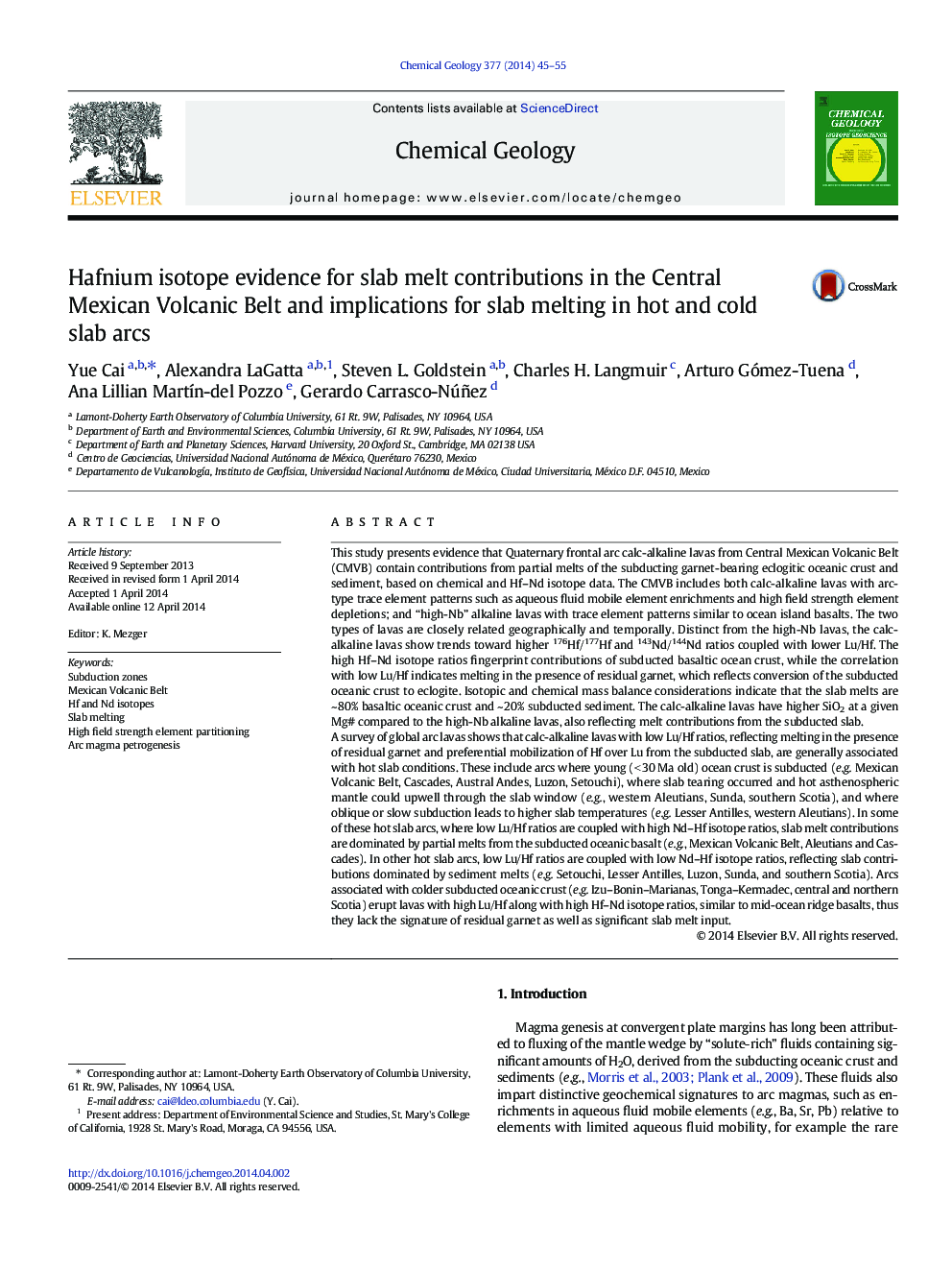| کد مقاله | کد نشریه | سال انتشار | مقاله انگلیسی | نسخه تمام متن |
|---|---|---|---|---|
| 4698772 | 1637594 | 2014 | 11 صفحه PDF | دانلود رایگان |
• CMVB arc lavas show chemical and isotopic signatures of melt contributions from the subducted Pacific ocean crust, with lower Lu/Hf correlating with higher εNd and εHf values.
• The subducted slab melt at the CMVB is composed of ~ 80% oceanic crust melt and ~ 20% sediment melt.
• Global hot slab arcs show low Lu/Hf correlating with slab-derived Hf and Nd, and high SiO2 contents for a given Mg#.
• Some hot slab arc lavas are dominated by basaltic oceanic crust melt, others by sediment melt.
• Cold slab arcs show high Lu/Hf ratios and high εNd and εHf values reflecting limited slab melt contributions.
This study presents evidence that Quaternary frontal arc calc-alkaline lavas from Central Mexican Volcanic Belt (CMVB) contain contributions from partial melts of the subducting garnet-bearing eclogitic oceanic crust and sediment, based on chemical and Hf–Nd isotope data. The CMVB includes both calc-alkaline lavas with arc-type trace element patterns such as aqueous fluid mobile element enrichments and high field strength element depletions; and “high-Nb” alkaline lavas with trace element patterns similar to ocean island basalts. The two types of lavas are closely related geographically and temporally. Distinct from the high-Nb lavas, the calc-alkaline lavas show trends toward higher 176Hf/177Hf and 143Nd/144Nd ratios coupled with lower Lu/Hf. The high Hf–Nd isotope ratios fingerprint contributions of subducted basaltic ocean crust, while the correlation with low Lu/Hf indicates melting in the presence of residual garnet, which reflects conversion of the subducted oceanic crust to eclogite. Isotopic and chemical mass balance considerations indicate that the slab melts are ~ 80% basaltic oceanic crust and ~ 20% subducted sediment. The calc-alkaline lavas have higher SiO2 at a given Mg# compared to the high-Nb alkaline lavas, also reflecting melt contributions from the subducted slab.A survey of global arc lavas shows that calc-alkaline lavas with low Lu/Hf ratios, reflecting melting in the presence of residual garnet and preferential mobilization of Hf over Lu from the subducted slab, are generally associated with hot slab conditions. These include arcs where young (< 30 Ma old) ocean crust is subducted (e.g. Mexican Volcanic Belt, Cascades, Austral Andes, Luzon, Setouchi), where slab tearing occurred and hot asthenospheric mantle could upwell through the slab window (e.g., western Aleutians, Sunda, southern Scotia), and where oblique or slow subduction leads to higher slab temperatures (e.g. Lesser Antilles, western Aleutians). In some of these hot slab arcs, where low Lu/Hf ratios are coupled with high Nd–Hf isotope ratios, slab melt contributions are dominated by partial melts from the subducted oceanic basalt (e.g., Mexican Volcanic Belt, Aleutians and Cascades). In other hot slab arcs, low Lu/Hf ratios are coupled with low Nd–Hf isotope ratios, reflecting slab contributions dominated by sediment melts (e.g. Setouchi, Lesser Antilles, Luzon, Sunda, and southern Scotia). Arcs associated with colder subducted oceanic crust (e.g. Izu–Bonin–Marianas, Tonga–Kermadec, central and northern Scotia) erupt lavas with high Lu/Hf along with high Hf–Nd isotope ratios, similar to mid-ocean ridge basalts, thus they lack the signature of residual garnet as well as significant slab melt input.
Figure optionsDownload as PowerPoint slide
Journal: Chemical Geology - Volume 377, 4 June 2014, Pages 45–55
